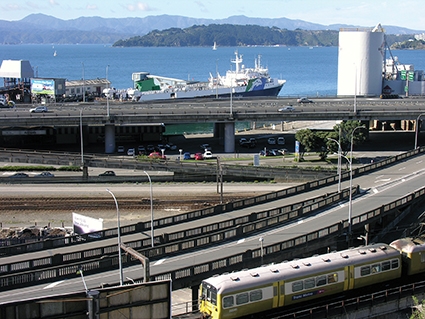Have You Heard about…the New European Transport Strategy?
In 2013, the European Commission, in a EUR 250 billion European strategy which gives priority to the creation of an integrated transport network and seeks to level the imbalance between the Member States of the European Union, proposed the creation of international transport corridors, bringing together Western and Central Eastern Europe. In order to overcome traffic imbalance in the EU, nine multimodal corridors will be created, each of which has to combine at least three types of transport and connect three states.
The new infrastructure policy will unite 28 EU states under trans-European transport network (TEN-T). Nine transport corridors will be provided: Baltic - Adriatic Sea, North Sea - Baltic, the Mediterranean Corridor, Middle Eastern Corridor, Scandinavia - the Mediterranean Sea, the Rhine - Alps, the Atlantic Corridor, the North Sea - the Mediterranean Sea, and the Rhine - Danube. They will be grouped into three general areas of “East - West”, “North - South” and “Diagonal” corridors. The project is scheduled for completion in 2030. The transport corridors will receive priority funding to connect the east and west of the European Union. To finance the first phase of the project, EUR 26 billion was allocated.
The Pan-European transport corridors were defined at the second Pan-European transport Conference in Crete, March 1994, as routes in Central and Eastern Europe that required major investment over the next ten to fifteen years. Additions were made at the third conference in Helsinki in 1997. As such, these corridors are sometimes referred to as the “Crete corridors” or “Helsinki corridors”, regardless of their geographical locations. A tenth corridor was proposed after the end of hostilities between the states of the former Yugoslavia. The new project focuses on the construction of high-speed railways.
At the first stage it is planned to create a single European rail traffic management system.
The general direction of “East - West” includes three transport corridors: North Sea - Baltic, the Mediterranean, and the Rhine-Danube corridor.
The North Sea - Baltic Corridor connects primarily the east coast of the Baltic Sea ports with the ports of the North Sea. It will run through eight countries (Finland, Lithuania, Latvia, Estonia, Poland, Germany, the Netherlands and Belgium). The Baltica motorway project will become part of the “old” trans-European corridor between Berlin and Finland.
There is a priority project in the railroad Rail Baltica. The Trans-European railway Rail Baltica, linking Helsinki – Tallinn – Riga – Kaunas – Warsaw and continuing on to Berlin, is to be developed within the territories of the co-operating EU Member States. Rail Baltica will support the wider EU goals of parity of access to services and infrastructure of EU Member States and development of sustainable modes of transportation, improved balance and interoperability between different means of transportation, and the establishment of links with the rest of the EU rail network. Even as far back as the 1990s it was in the works to build an underwater railway tunnel between Tallinn and Helsinki, but the project was delayed due to financial constraints. This corridor also involves the development of river waterways and canals (Belgium, Germany, the Netherlands), as well as ferry traffic (between Finland and Estonia). The project cost is estimated at over EUR 3.6 billion, including 50% from the EU budget (program TEN-T), and 50% from the budget of the project participants. In the Baltic countries there is no such means, and there are discussions about the feasibility of building a high-speed road which will pass by numerous settlements.
The Mediterranean Corridor connects the Mediterranean countries (Spain, France, Italy, Slovenia, Croatia) with Continental Hungary (up to the border with Ukraine). The basis of the corridor will be high-speed highways and railways. Reconstruction of railways will be carried out at intervals: Lyon - Turin and Venice - Ljubljana.
The Rhine - Danube Corridor must connect via the main water artery of Europe, as well as roads and railways passing along it, five of the Danubian States of the European Union. It will provide the main east–west link between continental European countries, connecting France and Germany, Austria, Slovakia, Hungary, Romania and Bulgaria all along the Main and Danube rivers to the Black Sea by improving (high speed) rail and inland waterway interconnections. The countries that first aligned with the project are the Czech Republic and Slovenia.
The direction “North - South” will strengthen transport links between the old and the most developed EU countries.
The Scandinavia - Mediterranean Corridor will connect major cities and ports in Scandinavia and Northern Germany with the industrial centers of Southern Germany, Austria and Northern Italy, as well as the ports of Italy and the island of Malta.
The Rhine Corridor through the Alps and Switzerland will connect the ports of the North Sea (Rotterdam and Antwerp) to the Mediterranean (Genoa).
The diagonal directions complement the directions “East - West” and “North – South,” including four corridors: Baltic - Adriatic Sea, North Sea - Mediterranean, Middle Eastern (Germany - Greece - Cyprus) and Atlantic corridors. They will join the developed countries of Western Europe with the Mediterranean.
The Atlantic Corridor will link Portugal and Spain (West), and France and Germany (East).
Germany intends to obtain from the European Union EUR 2.8 billion to improve transit transport systems which means a pass to six out of nine critical European transport corridors. The bulk of the subsidies from the EU (EUR 2.5 bn.) will be spent on development and improvement of the efficiency of railway infrastructure.
By 2030, the single European transport network will connect 94 sea and river ports, 38 international airports and 15.000 Km of high-speed railway.
Dimitri Dolaberidze is an expert in political-geography.
Dimitri Dolaberidze












